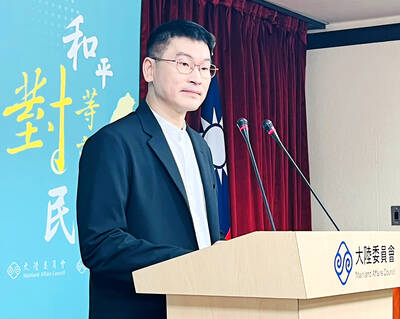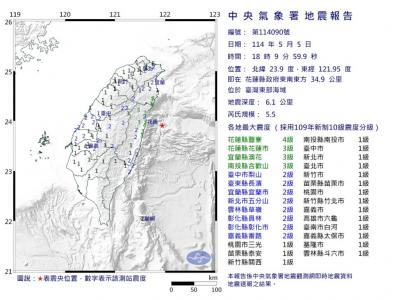Su Kai-nung (蘇楷儂) visits drug detoxification centers regularly to share his experience in kicking the habit. He frequents hospitals to cheer up cancer patients by soloing on the saxophone and serves as a division chief at a foundation established to promote the welfare and wellbeing of the physically and mentally challenged.
Su — a “veteran” drug addict suffering from late-stage lung cancer — works like a dervish every day, but is happy. Really happy.
Su was selected among 600 candidates nationwide as one of the six individuals who will receive on Saturday the prestigious Chou Ta-Kuan Award of Hope for his courage in facing life’s challenges and his determination to help others.

PHOTO: CHOU TA-KUAN, CNA
Viewing the young man playing What a Wonderful World on saxophone, one can hardly imagine that the 32-year-old spent most of his life in jail, depriving him of a normal education, and that, having nearly burnt himself out from drugs, he faces his deteriorating condition alone.
Mocking his involvement in illicit narcotics during the “dark days,” Su said during a visit to a drug abuse treatment center that he could just as easily have been awarded a master’s degree in drug abuse. Yet, he said the inner struggle is an even tougher battle than kicking the drug habit.
“If you think you can’t do it, you won’t,” he said.
Encouraging other addicts to believe they can combat their addiction, he urged them to accept help from others.
“You must accept others’ help. You can’t do it alone,” he said.
Su said he spent much of his childhood in a state of fear, dread or high anxiety. After his parents divorced, he lived with his grandmother, who was his only relative during his formative years.
He remembered always being the troublemaker in the eyes of his teachers in junior high school, from which he failed to graduate.
He was in jail for the first time on charges of using and possessing illicit narcotics at the age of 13. Since then, he split his time between prisons and hospitals, as he was not only a drug abuser but was also involved in street violence.
At the beginning, he said, the drugs would really calm him down, make him feel carefree and forget who he was and what he should do. Later, his addiction increased to a point where he could no longer live without drugs.
A few years later, he lost both his health and his long-term girlfriend.
Su said that his grandmother, who died a few years ago, was his first savior, adding that despite his leading a troubled life, his grandmother, a devout Christian, never abandoned him.
He said kicking the habit was hard, but not impossible. He recalled that his grandmother tried numerous times to use religion to save him, but in vain — until he attended a sermon in Taipei by an African American Evangelical minister from a church in New York. Toward the end of the service, he went to the front to receive prayer by the minister, asking to be led out of the darkness.
At that juncture, he said, he felt so clean inside and so happy that he was on his knees crying like a baby. For the first time, he met God and knew he was “saved,” he said.
From that day on, Su cut all his links with the drug world and stopped smoking, relying on God to find his strength.
Su has been clean for six years, working selflessly as a missionary of God, visiting correction centers to meet inmates and hospitals to console patients, as well as working as a volunteer for several organizations for the disabled.

An essay competition jointly organized by a local writing society and a publisher affiliated with the Chinese Communist Party (CCP) might have contravened the Act Governing Relations Between the People of the Taiwan Area and the Mainland Area (臺灣地區與大陸地區人民關係條例), the Mainland Affairs Council (MAC) said on Thursday. “In this case, the partner organization is clearly an agency under the CCP’s Fujian Provincial Committee,” MAC Deputy Minister and spokesperson Liang Wen-chieh (梁文傑) said at a news briefing in Taipei. “It also involves bringing Taiwanese students to China with all-expenses-paid arrangements to attend award ceremonies and camps,” Liang said. Those two “characteristics” are typically sufficient

A magnitude 5.9 earthquake that struck about 33km off the coast of Hualien City was the "main shock" in a series of quakes in the area, with aftershocks expected over the next three days, the Central Weather Administration (CWA) said yesterday. Prior to the magnitude 5.9 quake shaking most of Taiwan at 6:53pm yesterday, six other earthquakes stronger than a magnitude of 4, starting with a magnitude 5.5 quake at 6:09pm, occurred in the area. CWA Seismological Center Director Wu Chien-fu (吳健富) confirmed that the quakes were all part of the same series and that the magnitude 5.5 temblor was

The brilliant blue waters, thick foliage and bucolic atmosphere on this seemingly idyllic archipelago deep in the Pacific Ocean belie the key role it now plays in a titanic geopolitical struggle. Palau is again on the front line as China, and the US and its allies prepare their forces in an intensifying contest for control over the Asia-Pacific region. The democratic nation of just 17,000 people hosts US-controlled airstrips and soon-to-be-completed radar installations that the US military describes as “critical” to monitoring vast swathes of water and airspace. It is also a key piece of the second island chain, a string of

The Central Weather Administration has issued a heat alert for southeastern Taiwan, warning of temperatures as high as 36°C today, while alerting some coastal areas of strong winds later in the day. Kaohsiung’s Neimen District (內門) and Pingtung County’s Neipu Township (內埔) are under an orange heat alert, which warns of temperatures as high as 36°C for three consecutive days, the CWA said, citing southwest winds. The heat would also extend to Tainan’s Nansi (楠西) and Yujing (玉井) districts, as well as Pingtung’s Gaoshu (高樹), Yanpu (鹽埔) and Majia (瑪家) townships, it said, forecasting highs of up to 36°C in those areas